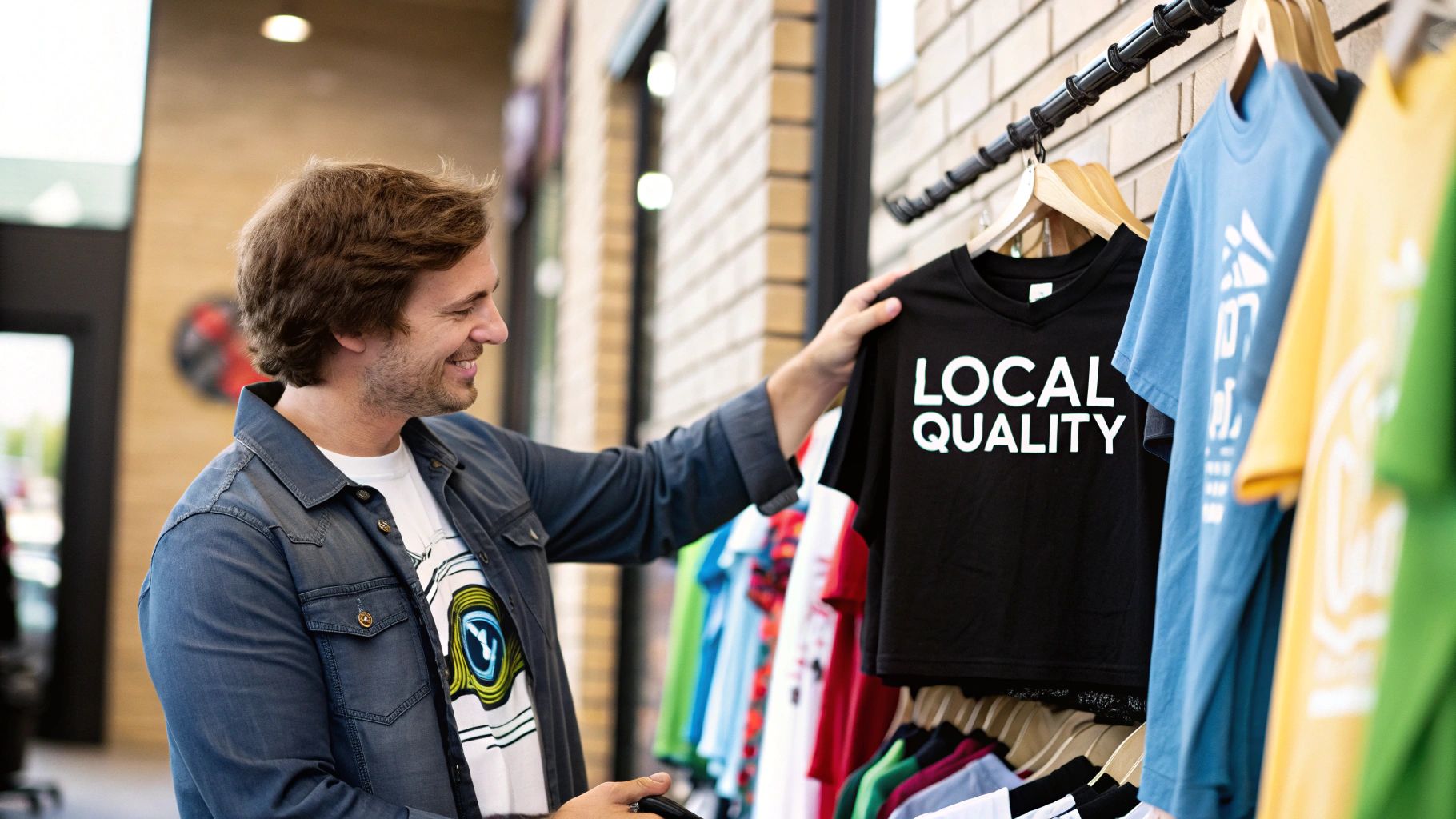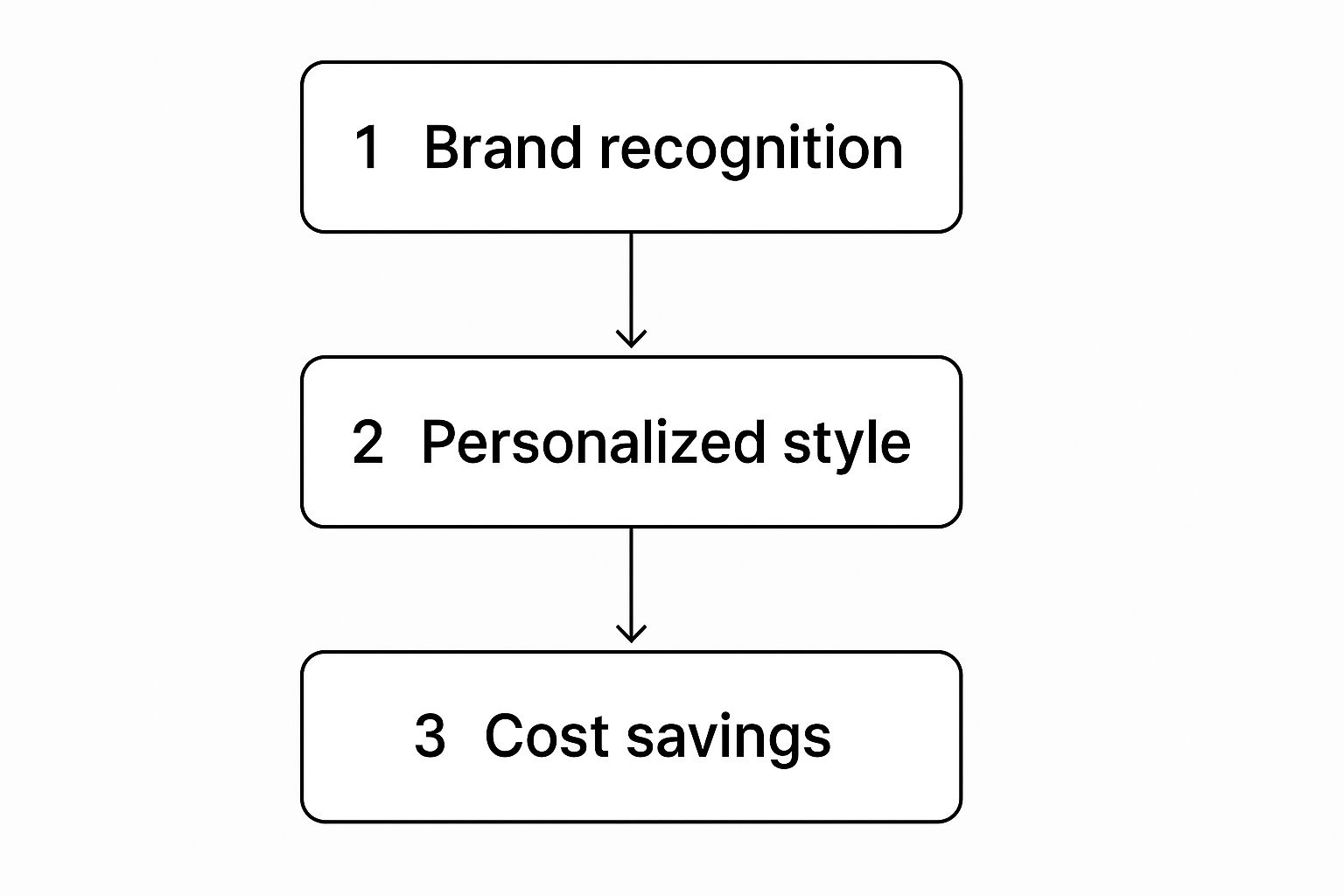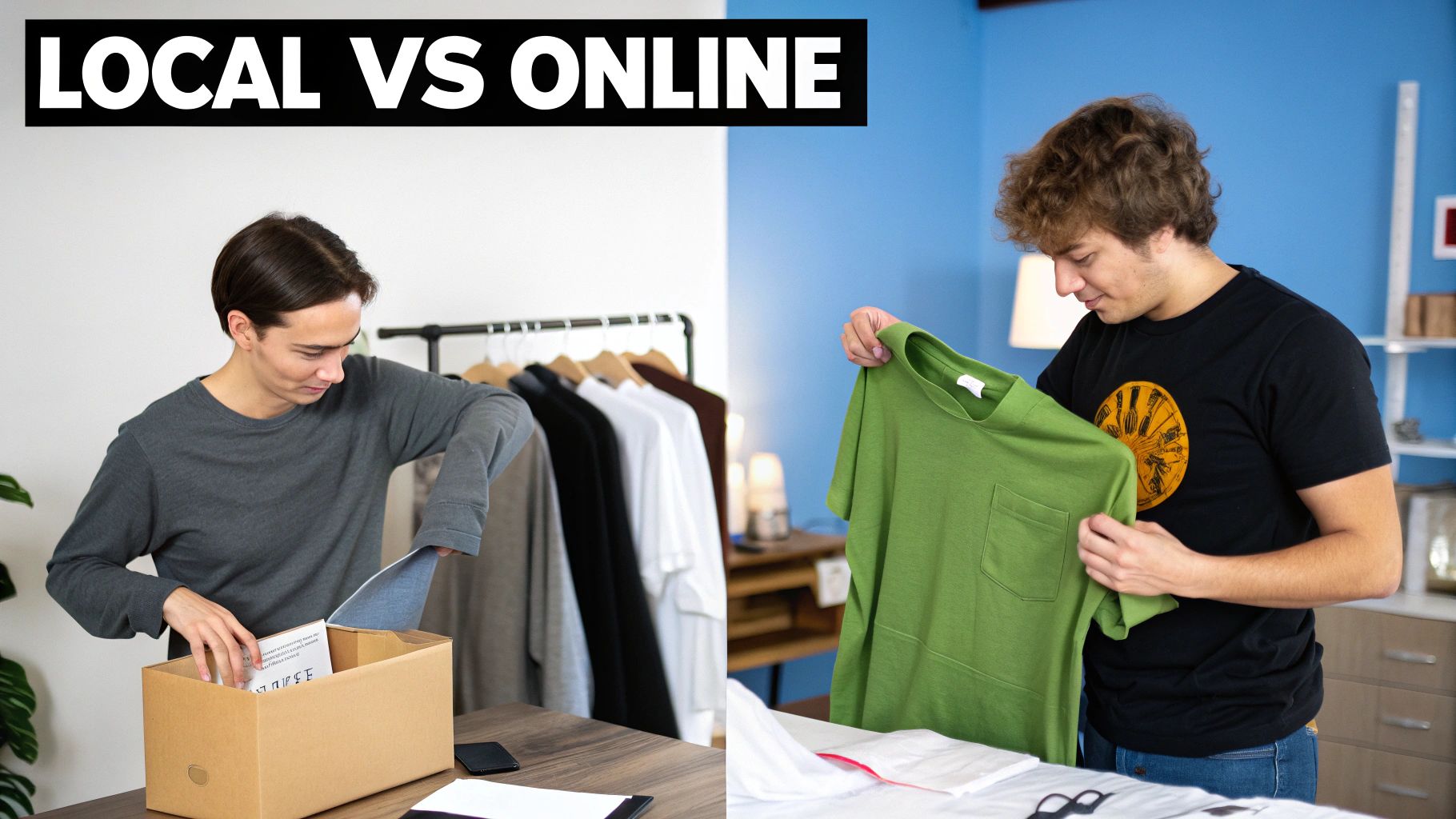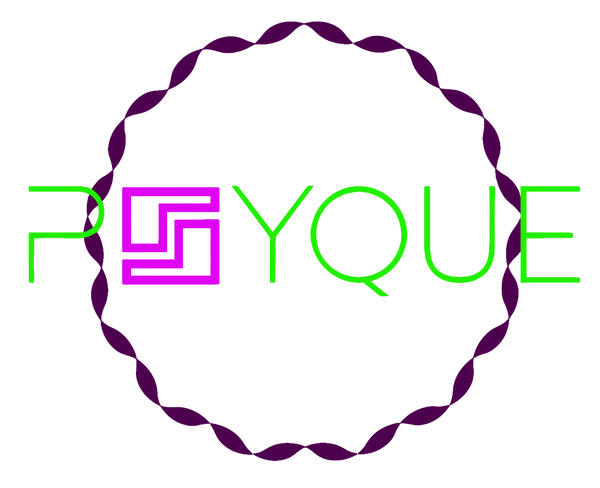
Find Custom Printed T-Shirts Near Me in the UK
Share
When you Google "custom printed t-shirts near me", you're not just looking for a product. You're looking for a local partner who gets it, someone who can help you drag that brilliant idea out of your head and onto a piece of cotton. Working with a UK-based printer has massive advantages, like faster turnaround times, actual human conversations, and the chance to physically touch and approve a sample. Trust me, that last part is a game-changer for getting things perfect.
Why Finding the Best Local T-Shirt Printers Matters
Choosing a local printer turns the whole thing from a faceless online transaction into a proper collaboration. You're building a relationship with experts in your community, not just clicking "add to basket." This isn't just about convenience; it's about quality control and tapping into years of hands-on experience that a chatbot just can't offer.

Assessing a Printer's Expertise
First things first: forget generic five-star ratings and get your eyes on their portfolio. Does their previous work actually look like what you need? For instance, if you want a detailed, multi-coloured graphic for your band's merch, you should be looking for examples of their Direct-to-Garment (DTG) printing. But if you need 200 bold, single-colour shirts for a corporate event, check out their screen printing gallery. The proof is in the print.
A great local printer doesn't just print; they consult. They should be able to guide you on the best printing method for your design, budget, and garment choice, ensuring the final product is durable and looks professional.
Asking the Right Questions Upfront
Before you commit, have a proper chat. Don't be shy about asking specific questions that reveal their real expertise and how they treat their customers. Our own guide on choosing custom t-shirt printers breaks down what to look for in a reliable partner.
Here are a few things you absolutely need to cover:
- Materials: What t-shirt brands and fabric types do they recommend? And more importantly, why?
- Process: Can they explain the difference between screen printing and DTG in a way that makes sense for your project?
- Samples: Can you see or feel a finished t-shirt? This is non-negotiable.
This early diligence helps you dodge a bullet. You want a printer who can handle a range of styles, from a simple logo to something more complex like a vibrant personalized color blast t-shirt.
To help you get started, here's a quick rundown of the most common local printing services you'll encounter.
Quick Guide to Local Printing Services
| Printer Type | Best For | Typical Turnaround | Key Advantage |
|---|---|---|---|
| Screen Printing | Bulk orders (50+), simple designs with few colours. | 1-2 weeks | Cost-effective for large quantities, very durable prints. |
| DTG (Direct-to-Garment) | Small batches, complex multi-colour designs, photos. | 3-7 days | Incredible detail and colour accuracy, no setup fees. |
| Heat Transfer Vinyl (HTV) | Individual names/numbers, small runs, simple text. | 1-3 days | Fast for one-offs, great for sportswear personalisation. |
| Embroidery | Polos, hats, workwear, premium logos. | 1-2 weeks | Professional, textured finish that lasts forever. |
This table should give you a solid idea of what to ask for when you start making calls.
The UK's custom t-shirt market is absolutely booming—it generated around USD 200.1 million in 2023. Screen printing still dominates, pulling in over 57% of that revenue thanks to its efficiency with bulk orders. This growth means you've got more local options than ever, which makes choosing the right one even more critical.
Decoding the Different Printing Methods
Once you've got a shortlist of local printers, it’s time to speak their language. Understanding the different printing methods is key to making sure your vision translates perfectly onto fabric—whether you need five shirts for your band or five hundred for a corporate event.
Honestly, the choice you make here will hit everything: the final look, the feel, the durability, and most importantly, the price.
Different projects call for different techniques, and it's about more than just the design. You need to consider the various printing methods that might utilize tools such as specialized heat presses or a quality iron for application and curing to get the job done right.
Screen Printing: The Bulk Order Champion
When you've got a big order and a bold, simple design, screen printing is the undisputed king. Think of it like a high-tech stencil. A custom mesh screen is made for each colour in your design, and ink is pushed through it directly onto the shirt. The result is a vibrant, incredibly tough print that can handle countless washes without cracking or fading.
The catch? All that screen prep takes time and money upfront. That’s why it’s only cost-effective for larger quantities. If you're printing 150 shirts for a local fun run, screen printing is your best bet. The price per shirt plummets as your order size goes up.
For a deeper dive into how it stacks up against newer methods, check out our guide on DTF vs screen printing for graphic tees.
Digital Printing for Detail and Flexibility
On the flip side, you’ve got digital printing, which includes popular methods like Direct-to-Garment (DTG). This is where things get really interesting. DTG is perfect for smaller, on-demand print runs with complex, multi-coloured designs and much faster turnarounds.

It’s basically like a high-end inkjet printer, but for fabric. This makes it the go-to choice for photorealistic images or intricate artwork—say, printing 15 different, colourful shirt designs for a band's merchandise table. There are no setup fees per colour, so one-offs and small batches are totally affordable.
Beyond DTG, there are other specialised options you might run into:
- Heat Transfer Vinyl (HTV): Best for simple text and numbers. This is what you see on the back of football jerseys.
- Dye Sublimation: The one for all-over prints on polyester sportswear. The ink literally becomes part of the fabric, so it never fades or cracks and feels like nothing is there.
Nail Your Design Files Before You Print
A killer t-shirt idea can be completely wrecked by a shoddy design file. Seriously. Before you even think about searching for "custom printed T-shirts near me," getting your artwork print-ready is the single most important thing you can do to make sure the final product looks sharp and professional, not like a blurry mess.

The first thing to get your head around is the difference between vector and raster files. It’s simpler than it sounds.
A raster image (like a .JPG or .PNG) is made of tiny squares called pixels. Ever tried to enlarge a small image and it just turned into a blocky, jagged disaster? That’s a raster file screaming for help. This is exactly why grabbing a low-res logo from a website and slapping it on a t-shirt design never works.
Vector files (AI, .EPS, or .SVG) are different. They use maths—lines and curves—to build the image. This means you can scale a vector design from the size of a postage stamp to a giant billboard, and it will stay perfectly crisp. No blurriness, no jagged edges. It’s why printers will almost always ask you for a vector file.
The Tech Specs That Actually Matter
File type is a big one, but a few other technical details can make or break your print. Get these right, and you’ll avoid a ton of frustrating emails and delays with your local printer.
- Resolution: If you absolutely must use a raster image, make sure it’s at least 300 DPI (dots per inch). This is the gold standard for high-quality printing. Anything less will look pixelated.
- Colour Mode: Your screen shows colours in RGB (Red, Green, Blue). Printers, however, use CMYK (Cyan, Magenta, Yellow, Black). Always convert your design to CMYK before sending it off. If you don't, the colours on your shirt might look completely different from what you saw on screen.
- Text as Outlines: This is a pro move. Convert all your text into shapes (a feature often called 'create outlines'). This locks the font in place, so you don't have to worry about the printer not having the specific font you used.
Getting your files right the first time isn't just about being tidy—it's about saving cash and time. Many printers will charge an extra fee to fix messy files, so a bit of prep work now literally pays for itself.
If you need a hand creating your artwork, plenty of user-friendly graphic design tools like Canva can help you bring your ideas to life. For a deeper dive, our guide on creating a personalised t-shirt print has more tips.
One final, crucial tip: always export your final design with a transparent background. Otherwise, you’ll end up with a big, ugly white box printed around your cool graphic.
File Format and Print Method Compatibility
Not all file formats play nicely with every print method. Choosing the right one from the start avoids technical headaches and ensures your design looks exactly as intended. Here’s a quick cheat sheet.
| Printing Method | Recommended File Type | Why It's Recommended |
|---|---|---|
| DTF (Direct to Film) | PNG, TIFF, PSD | Best for high-detail, full-colour raster images. PNGs with transparent backgrounds are perfect. |
| Screen Printing | AI, EPS, SVG | Vector is king here. It allows for clean separation of colours, which is essential for creating screens. |
| DTG (Direct to Garment) | PNG, TIFF | Similar to DTF, high-resolution raster files are ideal for capturing gradients and photographic detail. |
| Vinyl Cutting | SVG, AI, EPS | Vinyl cutters literally follow the vector paths to cut the design, so vector files are non-negotiable. |
Ultimately, the right file format ensures that what you designed on your screen is what ends up on your shirt. When in doubt, a high-resolution PNG or a clean vector file will cover you for most modern printing techniques.
How to Compare Quotes and Choose Your Printer
So, you’ve got a few quotes back for your custom T-shirts. This is where the real work begins. It’s tempting to just grab the lowest number and run, but that's a classic rookie mistake. The cheapest price often hides nasty surprises that blow your budget later on.
Real value isn’t about the lowest price—it's about transparency. A great quote might look a bit higher until you realise it includes VAT, delivery, and even the "screen setup" fee for screen printing. Some printers even charge extra for small artwork tweaks. Always demand a fully itemised quote. You need to know exactly what you’re paying for, down to the last penny.
Looking Beyond the Price Tag
The two biggest things that will swing your costs are the T-shirt itself and how many you’re ordering. There’s a world of difference between a basic Gildan tee and a premium, organic cotton shirt from a brand like Stanley/Stella. To make a fair comparison, make sure every printer is quoting on the exact same garment.
Volume is the other game-changer. The price per shirt drops off a cliff as your order size goes up. Ordering 50 tees will always be way more cost-effective per piece than just ordering 15. Double-check that every quote is for the same quantity.
Don't just pick the cheapest offer; pick the most transparent one. A good local printer will be upfront about all potential costs, making sure there are no shocks when the final invoice lands.
This is especially true in the UK's custom T-shirt printing scene, which has seen over 10% annual growth. That boom is fuelled by everyone from startups needing merch to local sports teams needing kits. If you want to dive deeper into the numbers, check out the full research on the custom printing market.
At the end of the day, you're not just buying shirts; you're looking for a reliable partner. For those based in the capital, our guide to custom T-shirt printing in London offers some more localised advice. Go with the printer who gives you a clear, comprehensive quote and communicates like a human being.
Nailing the Final Steps to Get Your T-Shirts
Right, you’ve waded through the search results for “custom printed t-shirts near me,” picked your printer, and given the quote the nod. The heavy lifting is done, but don’t switch off just yet. These final steps are where a good project becomes a great one, ensuring the tees you get are exactly what you pictured.

Before a single drop of ink hits the fabric, you'll get a digital proof or mock-up sent to your inbox. Treat this as the single most important email of the entire project. Seriously. This is your last line of defence against a sneaky typo, a colour that’s just a shade off, or a logo sitting a centimetre too low.
Don’t just glance at the mock-up on your phone and hit 'approve.' Open the file on a proper computer screen, zoom right in, and get a second pair of eyes on it. A simple spelling mistake caught here will save you from the gut-wrenching feeling of unboxing 50 t-shirts with an embarrassing error.
Once you give the green light, your order hits the production floor. Keep in mind that turnaround times can vary wildly depending on the print method. A small batch of DTG-printed shirts might be ready in a couple of days. But a complex, five-colour screen print order for 200 units? That could easily take a week or more because of all the screen prep involved.
Your Collection Day Quality Check
When the big day arrives and you go to collect your order, resist the urge to just grab the box and dash. Pop it open and inspect a few shirts from the top, middle, and bottom of the stack. A quick quality control check right there and then can save you a massive headache later.
Here’s a simple checklist to run through:
- Colour Accuracy: Is the red on the shirt the same vibrant red from the digital proof you signed off on?
- Print Placement: Is the design straight, centred, and positioned exactly where you wanted it?
- Garment Quality: Give the t-shirt itself a once-over. Are there any obvious defects like holes, stains, or loose threads?
- Print Clarity: Look closely at the design. Is it crisp and sharp? Or are there signs of bleeding, smudging, or cracking?
Running through these final checks makes sure the custom t-shirts you receive are the ones you paid for and envisioned from the start. No compromises.
Your Top Questions on Custom T-Shirt Printing, Answered
Jumping into the world of local t-shirt printing always brings up a few questions. Getting the right answers means you can budget properly, set the right expectations, and ultimately find the best local crew for your project.
Let's clear up some of the most common queries.
"What's the Minimum Order?"
This is the big one, and the answer almost always comes down to the print method.
If you’re going for classic screen printing, the setup is pretty intensive. That's why most local shops have a minimum order, usually around 20-25 shirts, to make the whole process worthwhile.
But if you’re looking at Direct-to-Garment (DTG) or heat transfer vinyl, you're in luck. These methods often have no minimums at all, making them perfect for a one-off prototype or a single, unique gift.
"How Can I Keep the Costs Down?"
Everyone wants to get the best bang for their buck without ending up with a naff product. The easiest way to save money is to order more. The price per shirt almost always drops as your quantity goes up—it's simple economics.
Another smart move? Simplify your design.
- Fewer Colours is Key: With screen printing, every single colour needs its own screen and a separate setup process. Each one adds to the final bill.
- Pick a Standard Tee: Instead of a niche, premium garment, ask the printer what their go-to, best-selling t-shirt brand is. They’re popular for a reason—good quality at a great price.
A question we hear all the time is, "Can I bring my own shirts?" While some printers might say yes, most would rather not. They've tested their process on specific brands they know will deliver a solid, quality print every time. Printing on a random shirt is a gamble—if there’s a misprint, that one-of-a-kind garment can't be replaced.
It's always best to ask about their policy on customer-supplied gear upfront. For a deeper dive, our complete guide on finding custom t-shirt printing near me walks you through all these points so you can make a choice you won't regret.
Ready to turn your idea into wearable art? At Psyque, we live and breathe high-quality DTF printing for custom gear that’s built to last. Check out our collections and kick off your project today at https://psyque.co.uk.
More articles:
Mastering T Shirt Design Polo for Your Brand
Find Custom Printed T-Shirts Near Me in the UK
Evil Wears Bunny Ears: The Streetwear Drop
Custom Printed T Shirts UK A Complete Guide
